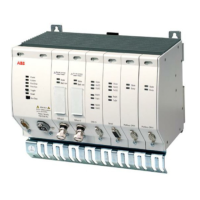4 Cabling the AC 800F
4-10
4.2 Cabling Ethernet modules
The same designations are used for the Ethernet components of the FieldController,
the AC 800F, the automation system Freelance 2000 and the operator system
Symphony to enable a common engineering basis for the two systems and the
AC 800F integrated into them. The following explanations apply to both the system
bus and the redundant communication bus.
The system bus of the AC 800F is based upon the widespread Ethernet standard.
“Ethernet”stands for LANs to DIN ISO 8802, Part 3 (corresponding to ISO 8802-3 and
ANSI/IEEE STD 802.3). The original Ethernet specification is slightly different from the
IEEE standard 802.3 valid today. However, this difference has no technical impact.
The following transmission media are available:
10Base2 Thin coaxial cable
10Base5 Thick coaxial cable
10BaseT Twisted pair cable
100BaseT or FF/HSE Twisted pair cable
10BaseFL Fiber optic cable
The standard 10Base2 - also known as Cheapernet - is based upon a thin coaxial
cable. Applications are short distance networks with few nodes connected via
10Base2 F-connectors.
A network in accordance with standard 10Base5 is based on a thick coaxial cable.
The nodes are connected via external transceivers. AUI cables link the nodes with the
transceivers. 10Base5 networks are used for medium-size installations located in one
building.
Usually, twisted pair (TP) cables are used for networks within one building. The
majority of them are unshielded twisted pair (UTP) cables. Good EMI/RFI shielding
capabilities are provided by shielded twisted pair (STP) cables. TP cable networks
can be extended easily, and the cables and equipment are quite economic. Two
nodes can be connected directly via a cross cable, without requiring additional
equipment. If more than two nodes are on the network, they have to be coupled
through so-called hubs, which are available in different variants.
The transmission standard 10BaseFL is based on fiber optic cables and provides
good EMI/RFI shielding and protective separation of the nodes. An active network
concentrator is needed for operation.
The following sections describe the transmission standards used and the respective
technical data.

